INSTITUT SUPERIEUR D'ANTHROPOLOGIE
INSTITUTE OF ANTHROPOLOGY
ONLINE COURSES / COURS A DISTANCE
INSCRIPTION 2012 / Session II : Avril 2012
REGISTRATION 2012 / Term II : April 2012
ROYAUME UNI – 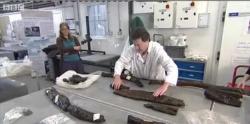 Bouldnor - An 8,000-year-old "High Street" has been discovered in the Solent by Hampshire archaeologists. The Hampshire and Wight Trust for Maritime Archaeology has been working on the underwater section near Bouldnor since 1999. However, it was only last summer they discovered the boat-building site, which has not been disturbed for centuries. The discovery is of international importance according to the trust, as it sheds new light on how people lived in the Mesolithic period.
Bouldnor - An 8,000-year-old "High Street" has been discovered in the Solent by Hampshire archaeologists. The Hampshire and Wight Trust for Maritime Archaeology has been working on the underwater section near Bouldnor since 1999. However, it was only last summer they discovered the boat-building site, which has not been disturbed for centuries. The discovery is of international importance according to the trust, as it sheds new light on how people lived in the Mesolithic period.
VIDEO = http://www.bbc.co.uk/news/uk-england-hampshire-17060174
NOUVELLE ZELANDE – 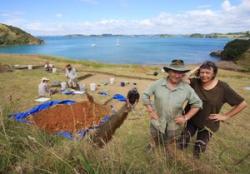 Oihi Bay - An archaeological investigation at Oihi Bay, site of the earliest permanent European habitation in New Zealand, is revealing some fascinating details of life in the Bay of Islands in a very different era. The pickings have been rich; so far they have discovered numerous writing slates and pencils, a toy cannon, glass beads (commonly used for trade), a bronze bracelet (complete with a clasp still in working order), nails and pieces of ceramic. But the most exciting find as of earlier this week was the fireplace in what they believe to have been New Zealand's first school house. "The most interesting feature is the fireplace. You know you've got a house when you find a fireplace," Dr Middleton said. "The clay marble, the toy cannon - immediately you have the sense that there were children here," she added.
Oihi Bay - An archaeological investigation at Oihi Bay, site of the earliest permanent European habitation in New Zealand, is revealing some fascinating details of life in the Bay of Islands in a very different era. The pickings have been rich; so far they have discovered numerous writing slates and pencils, a toy cannon, glass beads (commonly used for trade), a bronze bracelet (complete with a clasp still in working order), nails and pieces of ceramic. But the most exciting find as of earlier this week was the fireplace in what they believe to have been New Zealand's first school house. "The most interesting feature is the fireplace. You know you've got a house when you find a fireplace," Dr Middleton said. "The clay marble, the toy cannon - immediately you have the sense that there were children here," she added.
http://www.northernadvocate.co.nz/news/an-archaeological-investigation-at-oihi-bay-site-o/1274265/
NOUVELLE ZELANDE – 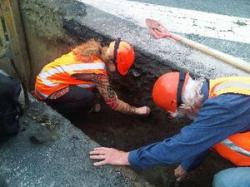 Redcliffs - Moa bones and other relics of Maori settlement around Redcliffs have been found during excavations at the Main Rd for a wastewater pipe.
Redcliffs - Moa bones and other relics of Maori settlement around Redcliffs have been found during excavations at the Main Rd for a wastewater pipe.
Fulton Hogan, working for Stronger Christchurch Infrastructure Rebuild Team, appointed archaeologist Michael Trotter to monitor the excavation. The work found evidence of early Maori occupation dating back about 600 years, including earth ovens (hangi) and the remains of cooked food including shellfish, seals, dogs, and moas. A bead made out of a fossilised shell and a workshop area where stone adze heads were crafted was also discovered. The most significant find was a small clay ball that had been baked in a fire.
http://www.starcanterbury.co.nz/news/archaeologists-uncover-moa-bones/1269633/
USA – Malibu - Large Chumash and pre-Chumash cemeteries are known to have existed at Arroyo Sequit, Trancas Canyon, Point Dume, Paradise Cove, Solstice Canyon and Malibu Lagoon, and archaeologists estimate that there are hundreds of smaller grave sites scattered throughout the Santa Monica Mountains. A number of significant Chumash sites were leveled or buried in the 1930s and 1940s to make way for Pacific Coast Highway. Archeologist E.K. Burnett, in a monograph published in 1944, describes numerous finds hastily excavated by teams attempting to survey and catalog sites before road crews bulldozed them. Other cemeteries were excavated between 1915 and the 1970s. An inventory of human remains at the Los Angeles County Natural History Museum that was published in 2007 to meet the requirements of the 1990 Native American Graves Protection and Repatriation Act encompasses numerous Malibu entries. Examples include: "In 1915, human remains representing a minimum of two individuals were removed from 'the Malibu Ranch,' an unknown location in Los Angeles County, CA. The human remains were subsequently donated to the Natural History Museum of Los Angeles County by Irving V. Auger. No known individuals were identified. No associated funerary objects are present"; "at an unknown date, human remains representing a minimum of 13 individuals were removed from Arroyo Sequit Mound in Arroyo Sequit. "The human remains were subsequently donated to the Natural History Museum byE.D. Mitchell. One set of human remains was identified by a tag reading 'EDM. 281, burial 18, Arroyo Sequit Mound." The other 12 sets of human remains were identified by a tag reading 'California Los Angeles County Arroyo Sequit Shell Mound Misc. Bones EDM-274'"; and "At an unknown date, human remains representing a minimum of three individuals were removed from a site in Solstice Canyon. The human remains were subsequently donated to the Natural History Museum of Los Angeles County in 1971 by the Native Daughters of the Golden West." The Trancas Canyon Cemetery site, or CA-LAN-197, was initially excavated in 1968 by a group of Malibu residents. UCLA archaeologists David Thomas and John Beaton later stepped in to supervise the excavation.
http://malibusurfsidenews.com/stories/201202/201202160004.html
TUNISIE - el Kantra - A chance discovery of around 100 Roman graves was made recently near el Kantra - located in the island of Djerba's southern region. Employees working for the STEG (the Tunisian Society of Electricity and Gas) as well as employees from the Ministry of Equipment and Housing uncovered the graves while they were carrying out work in the region. An employee from the STEG, who was present when the discovery was made, confirmed that while the staff was digging to repair a gas pipeline they discovered fragments of marble, pottery, clothes, coins, and human bones. The employees did not recognize that the area was a cemetery until they invited archaeologists to investigate the site. Youssef el Cherif, a Tunisian archaeologist, confirmed that the graves discovered in "el Kantra" appeared to be connected to the archaeological site of Meninx. Originally a manufacturing center established by Phoenicians as early as the 10th Century BC, Meninx developed into an important and prosperous economic city under the Romans thanks to its strategic position at the geographical crossroads of ancient trade routes. At its peak Meninx was the capital of the island and boasted thermal baths, an amphitheater, a theater, a basilica and possibly a forum. A team of archaeologists will begin a more detailed investigation of the new discovery in the coming days.
http://allafrica.com/stories/201202151008.html
ROYAUME UNI – 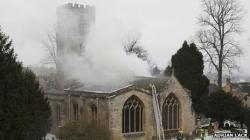 Charlbury - Fire crews worked for 12 hours to save a 900-year-old Oxfordshire church from going up in flames. Firefighters were called to St Mary the Virgin Church in Charlbury at 12:00 GMT as plumes of thick smoke were coming from the church roof. They were forced to saw through the roof in order to create a fire break to stop the flames spreading. The church was part Norman and parts had also been constructed in the 14th and 15th Centuries. "Unfortunately the part of the roof which was burnt was 15th Century,
Charlbury - Fire crews worked for 12 hours to save a 900-year-old Oxfordshire church from going up in flames. Firefighters were called to St Mary the Virgin Church in Charlbury at 12:00 GMT as plumes of thick smoke were coming from the church roof. They were forced to saw through the roof in order to create a fire break to stop the flames spreading. The church was part Norman and parts had also been constructed in the 14th and 15th Centuries. "Unfortunately the part of the roof which was burnt was 15th Century,
http://www.bbc.co.uk/news/uk-england-oxfordshire-17009590
EGYPTE – 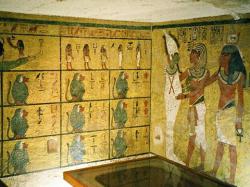 Vallée des Rois - On Feb. 16, 1923, the burial chamber of King Tutankhamen’s recently unearthed tomb was unsealed in Egypt. King Tutankhamen’s tomb is situated in the Valley of the Kings, east of the Nile River in Egypt. In 1907, the English archaeologist Edward Russell Ayrton uncovered a pit in the area containing pots, dishes and other objects belonging to Tutankhamun, then a relatively unknown 14th-century B.C. pharaoh. Mr. Ayrton’s sponsor, the American Theodore M. Davis, proclaimed that he had discovered Tutankhamun’s tomb and donated some of the objects to New York’s Metropolitan Museum of Art. After years of study, Herbert Winlock, a curator at the Met, determined that the objects were left over from the embalming process and funeral, and that the pit was not actually Tutankhamun’s tomb. Mr. Winlock theorized that Tutankhamun was likely buried nearby. The English archaeologist Howard Carter corresponded with Mr. Winlock and decided to search for the tomb. Funded by Lord Carnarvon, he began excavating the area in 1914 and found nothing for seven years. Lord Carnarvon considered giving up. On Nov. 4, 1922, Mr. Carter finally uncovered the door of Tutankhamun’s tomb. After three weeks of removing stone and rubble from a corridor behind the door, Mr. Carter reached a second sealed door. With Lord Carnarvon watching, Mr. Carter opened the door slightly and held up a candle that revealed gold statues, beds and hundreds of other objects in the room behind the door. Mr. Carter and his team spent nearly three months cataloging and removing objects from the tomb before he was able to reach the burial tomb. On Feb. 16, he began taking down the door to the burial tomb. “It finally ended in a wonderful revelation,” The Times wrote, “for before the spectators was the resplendent mausoleum of the king, a spacious and beautifully decorated chamber completely occupied by an immense shrine covered with gold inlaid with brilliant blue faience. This beautiful wooden construction towers nearly to the ceiling and fills the great sepulchral hall within a short span of its four walls. Its sides are adorned with magnificent religious texts and fearful symbols of the dead.” Tutankhamun’s tomb was and remains the best preserved royal tomb ever discovered. Mr. Carter spent the next eight years removing objects from the tomb, most of which are now held at the Egyptian Museum in Cairo or displayed on tours. He opened Tutankhamun’s sarcophagus in February 1924, revealing the pharaoh’s mummy for the first time.
Vallée des Rois - On Feb. 16, 1923, the burial chamber of King Tutankhamen’s recently unearthed tomb was unsealed in Egypt. King Tutankhamen’s tomb is situated in the Valley of the Kings, east of the Nile River in Egypt. In 1907, the English archaeologist Edward Russell Ayrton uncovered a pit in the area containing pots, dishes and other objects belonging to Tutankhamun, then a relatively unknown 14th-century B.C. pharaoh. Mr. Ayrton’s sponsor, the American Theodore M. Davis, proclaimed that he had discovered Tutankhamun’s tomb and donated some of the objects to New York’s Metropolitan Museum of Art. After years of study, Herbert Winlock, a curator at the Met, determined that the objects were left over from the embalming process and funeral, and that the pit was not actually Tutankhamun’s tomb. Mr. Winlock theorized that Tutankhamun was likely buried nearby. The English archaeologist Howard Carter corresponded with Mr. Winlock and decided to search for the tomb. Funded by Lord Carnarvon, he began excavating the area in 1914 and found nothing for seven years. Lord Carnarvon considered giving up. On Nov. 4, 1922, Mr. Carter finally uncovered the door of Tutankhamun’s tomb. After three weeks of removing stone and rubble from a corridor behind the door, Mr. Carter reached a second sealed door. With Lord Carnarvon watching, Mr. Carter opened the door slightly and held up a candle that revealed gold statues, beds and hundreds of other objects in the room behind the door. Mr. Carter and his team spent nearly three months cataloging and removing objects from the tomb before he was able to reach the burial tomb. On Feb. 16, he began taking down the door to the burial tomb. “It finally ended in a wonderful revelation,” The Times wrote, “for before the spectators was the resplendent mausoleum of the king, a spacious and beautifully decorated chamber completely occupied by an immense shrine covered with gold inlaid with brilliant blue faience. This beautiful wooden construction towers nearly to the ceiling and fills the great sepulchral hall within a short span of its four walls. Its sides are adorned with magnificent religious texts and fearful symbols of the dead.” Tutankhamun’s tomb was and remains the best preserved royal tomb ever discovered. Mr. Carter spent the next eight years removing objects from the tomb, most of which are now held at the Egyptian Museum in Cairo or displayed on tours. He opened Tutankhamun’s sarcophagus in February 1924, revealing the pharaoh’s mummy for the first time.
http://learning.blogs.nytimes.com/2012/02/16/feb-16-1923-king-tuts-burial-chamber-unsealed/